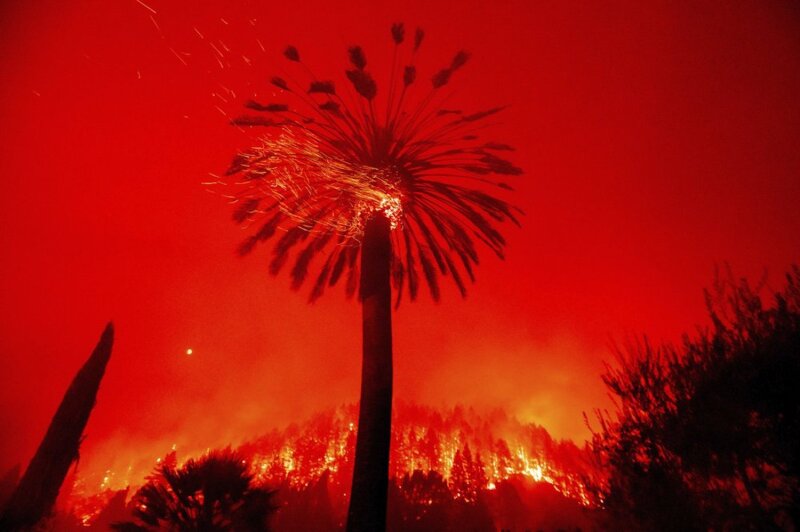Northern California’s wine country was on fire again Monday as strong winds fanned flames in the already scorched region, prompting evacuation orders involving more than 50,000 people.
Residents of the Oakmont Gardens assisted living home in Santa Rosa boarded brightly lit city buses overnight, some wearing bathrobes and using walkers. They wore masks to protect against the coronavirus as orange flames marked the dark sky.

Embers fly from a tree as the Glass Fire burns in St. Helena, California.
Photo by Noah Berger/AP
Flames also engulfed the Chateau Boswell Winery north of St. Helena. The Adventist Health St. Helena hospital suspended care and transferred all patients elsewhere, according to a statement on its website.
“We just don’t have words,” State Senator Mike McGuire, a Democrat who represents Healdsburg, told KTVU-2 in Oakland. “It’s an incredibly trying and emotional time right now.”
The fires that began Sunday in the famed Napa-Sonoma wine country north of San Francisco came almost exactly three years after deadly wildfires that erupted in 2017, including one that killed 22 people.
The latest inferno began with the Glass Fire at 3:50 a.m. Sunday and two subsequent fires merged with it, burning 17 square miles as of early Monday, according to the California Department of Forestry and Fire Protection, or Cal Fire.
More than 53,000 people in Sonoma and Napa Counties were under evacuation orders, said Daniel Berlant, assistant deputy director with Cal Fire. Many more have been warned that they may have to flee.
Paul Lowenthal, another Cal Fire spokesman, said more than 13,000 homes were threatened in Santa Rosa alone.
“In some parts of Santa Rosa, they’re mopping up hot spots,” he said. “In other parts, they’re still actively fighting fire.”
Sonoma County Supervisor Susan Gorin evacuated her home in the Oakmont community of Santa Rosa about 1 a.m. She is rebuilding a home damaged in the 2017 fires. Gorin told the San Francisco Chronicle that she is numb, and the situation feels surreal.
“It’s like God has no sympathy, no empathy for Sonoma County,” she told the news publication.
Evacuations were also ordered in Shasta County as the Zogg Fire spread over 23 square miles. Residences are widely scattered in the forested area, about 10 miles southwest of the city of Redding in a region torched just two years ago by the massive and deadly Carr Fire—infamously remembered for producing a huge tornado-like fire whirl.
The causes of the new fires were under investigation.
Global warming’s role
Numerous studies in recent years have linked bigger wildfires in America to global warming from the burning of coal, oil, and gas, especially because climate change has made California much drier. A drier California means plants are more flammable.
The latest fires erupted as a giant ridge of high pressure settled over the West, producing powerful gusts blowing from the interior toward the coast while slashing humidity levels and raising temperatures, making vegetation ready to burn.
During the weekend, Pacific Gas & Electric turned off electricity to targeted areas where the winds raised the potential for arcing or other power equipment damage that could spark new fires. The utility’s equipment has caused previous disasters, including the 2018 Camp Fire that devastated the Sierra Nevada foothills town of Paradise and killed 85 people.
So far this year, more than 8,100 California wildfires have scorched 5,780 square miles, destroyed more than 7,000 buildings and killed 26 people.
Most of the losses occurred after a frenzy of dry lightning strikes in mid-August ignited a massive outbreak of fires.
Fire worries were also developing Monday across Southern California although it was unclear how strong predicted Santa Ana winds would be. Heat and extreme dryness were expected to be problematic nonetheless.
Conditions were also hot, dry, and windy in parts of Arizona, where the Sears Fire in Tonto National Forest north of Phoenix has grown to more than 14 square miles since it erupted Friday afternoon. Authorities reported zero containment.
AP writer John Antczak in Los Angeles contributed to this report.








